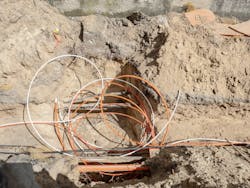Worldwide fiber-optic cable shortage looms over 5G, data center infrastructure rollouts
As reported by Anna Gross for Financial Times (FT.com), the market intelligence firm Cru Group has now revealed that a worldwide shortage of fiber-optic cable has driven up product pricing and lengthened lead times on supply, casting a shadow over ambitious industry plans for advanced telecommunications infrastructure rollouts.
As noted by the FT.com reporting, the timing couldn't be worse. Governments around the world have set ambitious targets for the rollout of superfast broadband and 5G infrastructure, both of which of course require vast quantities of fiber-optic cable to be laid underground. Meanwhile, the report notes how companies such as Amazon, Google, Microsoft and Facebook owner Meta are in the process of expanding their data center footprints around the world to meet soaring demand, including globe-spanning deployments of subsea fiber-optic cabling.
Fiber price spike is highest in 3 years
According to Cru's analysis per FT.com reporting, prices for fiber have now reached their highest level since July 2019. North America has been less severely impacted than Europe, China and India -- but that may not be for long.
Meanwhile, the price balloon has led to significantly increased lead times for fiber, stretching from 20 weeks to nearly a year for smaller customers, according to the report. “All of us are prioritizing giving fastest delivery to our biggest customers,” Ankit Agarwal, managing director of STL, one of the largest fiber suppliers in the UK, told FT.com.
Cru Group said Europe, India and China are among the global regions most affected by the price increases, with the cost of fiber rising as much as 70% from a record low in March 2021, from $3.70 to $6.30 per fiber km, according to the analyst.
The report noted that total cable consumption increased by 8.1 per cent in the first half of 2022 compared with the same time last year, as estimated by Cru.
The analyst said that China accounted for 46% of total consumption, with North America representing the fastest growing region, at 15% year-over-year.
As quoted by FT.com, “In my professional career I’ve never seen anything like this inflationary crunch,” stated Wendell Weeks, CEO of Corning, among the top global producers of fiber-optic cabling. Weeks noted that the company has been significantly ramping production to meet exponential demand from governments, telecom firms and large technology players, including the construction of new facilities in the U.S. and Europe.
Raw materials costs rise
Significantly, the reporting emphasizes that, at root of the cabling shortage are rising prices for some of the critical components that go into fiber-optic technology manufacturing.
Primarily, a shortage of helium, a crucial component in fiber-optic glass manufacturing, has in part been caused by plant outages in Russia and the U.S., which has caused prices of the element to increase by 135% over the past two years, stated the report.
Meanwhile, the price of silicon tetrachloride, another key component in fiber-optic manufacturing, has gone up by as much as 50%, according to Cru.
“Given that the cost of deployment has suddenly doubled, there are now questions around whether countries are going to be able to meet targets set for infrastructure build, and whether this could have an impact on global connectivity,” Michael Finch, an analyst at Cru, told FT.com.
For more news, projects, and profiles in the ICT cabling and connectivity industry, subscribe to CI&M’s newsletter and follow us on LinkedIn, Twitter, and Facebook.
About the Author
Cabling Installation & Maintenance Staff
Cabling Installation & Maintenance publishes news and technical information for information and communications technology (ICT) professionals.
